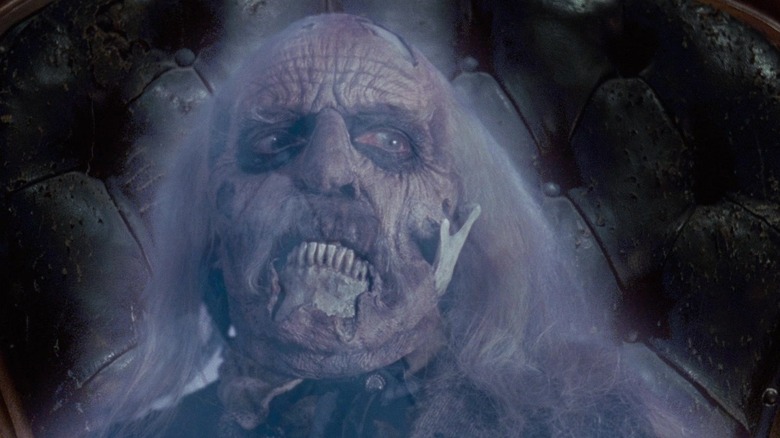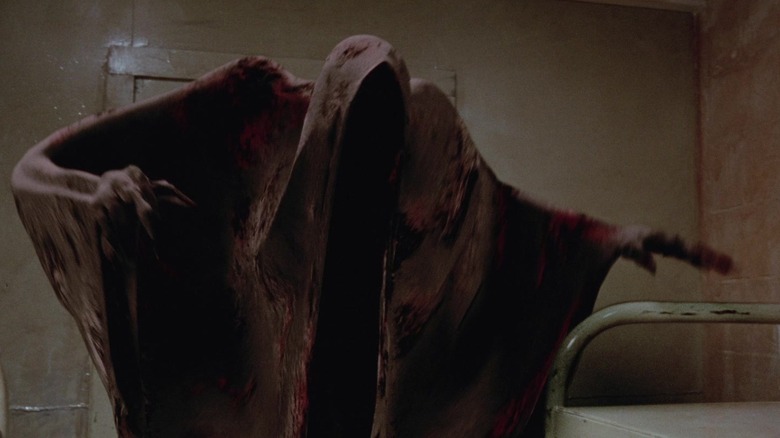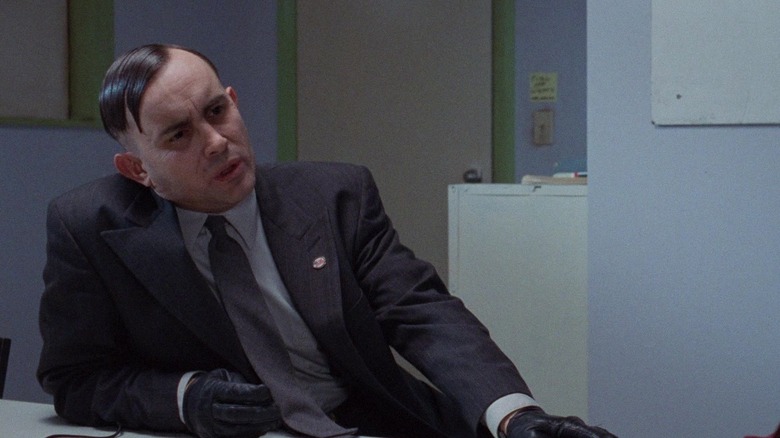Peter Jackson's First Studio Movie Was A Critical Success (But A Box Office Bomb)
We may receive a commission on purchases made from links.
Before his foray into J.R.R. Tolkien, New Zealand director Peter Jackson was better known for his striking and putrid horror movies. His first feature, 1987's "Bad Taste," was made for only $25,000, and features scenes of people drinking vomit, and a climax wherein a hero dives through a space alien's body with a chainsaw. He chased that with 1989's "Meet the Feebles," a sendup of the Muppets wherein the puppet performers were addicted to drugs, filming porn in the basement, and dealing with the travails of venereal disease. Jackson's magnum opus, "Braindead" (a.k.a. "Dead Alive") came in 1992, and to this day it remains one of the goriest films of all time.
Jackson diversified his filmography in 1994 with "Heavenly Creatures," a stylized biopic of Juliet Hulme (Kate Winslet) and Pauline Parker (Melanie Lynskey), two teenage girls who committed a murder together in 1952. The film made Jackson something of an indie film darling, and critics outside of the horror community began to take notice. After the tiny release of a 1995 mockumentary called "Forgotten Silver," Jackson was ready for the big time.
In 1996, he released "The Frighteners," a high-profile studio film distributed by Universal Pictures. It boasted a high-profile cast including Michael J. Fox, John Astin, and Dee Wallace. Danny Elfman provided the score. It had the highest budget of any Jackson film to date, costing $26 million. Also new for Jackson was his extensive use of CGI; most of the film's ghosts were realized in computers, an about-face from his bloody, gory, all-practical films like "Braindead." Jackson, of course, would go ham with the CGI with his next film, "The Lord of the Rings: The Fellowship of the Ring" five years later.
"The Frighteners" was well-enough-received by critics, although it was a box office bomb. It ended up making only $29.3 million at the box office and remains Jackson's biggest commercial loss to date.
Critics kind of liked The Frighteners
In "The Frighteners," Fox plays Frank Bannister, a paranormal investigator who goes to people's houses to exorcize their ghosts. What his clients don't know is that he and the ghosts (played by Chi McBride and Jim Fyfe) are actually in league, and they collectively stage hauntings and their subsequent exorcisms just to make a quick buck. Frank can see ghosts after having a near-death experience in a car wreck, a wreck that took the life of his wife.
The plot of "The Frighteners" involved Frank's discovery of an eerie, invisible, death-like specter that is brazenly causing heart attacks throughout his sleepy hometown. The specter might have something to do with the cloistered weirdo Patricia (Wallace), who dated a now-executed serial killer (Jake Busey) when she was a teen. Patricia, as seen in an introduction, has to fight off the specter on a nightly basis when it stalks her through her home. Trini Alvarado plays the sympathetic Lucy Lynskey (named after the "Heavenly Creatures" star), who provides the film with real human emotions, and Jeffrey Combs turns in a career-best "oddball" performance as FBI Agent Dammers, a mentally unstable maniac who had lived for too many years undercover with Satanic cults.
The Elfman score and Gothic visuals — not to mention Robert Zemeckis' presence as an executive producer — give away that "The Frighteners" began its production life as a potential "Tales from the Crypt" spinoff. The film is wild and chaotic, and the digital effects are subpar, but it's still fun. On Rotten Tomatoes, it has a modest 67% approval rating (still technically "Fresh") based on 44 reviews. Roger Ebert hated it, giving it only one star out of four, but Kenneth Turan loved its spinning, whirligig energy, giving it four stars out of five.
The Frighteners had more CGI than almost any film in history up to that point
The effects on "The Frighteners" were so extensive, however, that the entire movie felt more like a demo reel than a movie. The film was shot in Lyttelton, New Zealand, and several miniature sets had to be built to make it look more like an American town. The ghosts were part-ghost and part-zombie, with actors Astin, Fyfe, and McBride given bony or bloody makeup to imply they were rotting. On top of that, though, the ghosts were given an eerie, translucent, blue glow, which seems like putting a hat on a hat.
The death specter was entirely animated, but could also press on walls, causing them to stretch out toward his victims. The VFX were provided by the Weta Workshop, then still relatively new and inexperienced with computers. They bit off more than they could chew with "The Frighteners," and a lot of the animation looks smooth and false, a problem with '90s-era CG effects. It seemed that Jackson wanted to prove that he could work with digital effects, and decided to go whole hog. The effects are unique, but they do look a little cheap. They did at the time.
"The Frighteners," as mentioned, was a big bomb. It opened in theaters on July 19, 1996, only two weeks after Roland Emmerich's "Independence Day," which was still burning up the box office. Jackson said in Brad Silbey's 2016 biography, "Peter Jackson: A Film-maker's Journey," that he also blamed the opening of the 1996 Olympic Games in Atlanta as a distraction, and the vague marketing campaign by Universal. The posters were merely a ghostly face on a white background with the tagline "Dead yet?" Jackson felt they weren't descriptive enough.
Whatever the reason, "The Frighteners" fell by the wayside. At the very least, Jackson's demo reel worked and landed the high-profile "Lord of the Rings" gig a few years later. Those films, if I recall, were slightly more successful.


